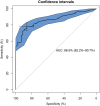Psychometric properties of the Italian body shape questionnaire: an investigation of its reliability, factorial, concurrent, and criterion validity
- PMID: 36352341
- PMCID: PMC9803762
- DOI: 10.1007/s40519-022-01503-6
Psychometric properties of the Italian body shape questionnaire: an investigation of its reliability, factorial, concurrent, and criterion validity
Abstract
Purpose: This study was set up to investigate the reliability, factorial, concurrent, and criterion validity of the Italian version of the 34-item Body Shape Questionnaire (BSQ) and its shorter versions.
Methods: The study included 231 patients diagnosed with an eating disorder and 58 putatively healthy people (comparison sample). The Italian BSQ-34 was administered to participants together with the Hamilton Depression Rating Scale and the Hamilton Anxiety Rating Scale. Information on body mass index, caloric intake at baseline, and the number of episodes of self-vomiting per week was also acquired.
Results: Cronbach's alpha of BSQ-34 was 0.971 (95% confidence interval [CI] 0.965-0.976) in patients and 0.960 (0.944-0.974) in controls. Test-retest stability in patients (n = 69), measured with intraclass correlation coefficient, was 0.987 (0.983-0.991). Confirmatory factor analysis of the single-factor model yielded acceptable fit for all versions of the BSQ. On all BSQ versions, patients scored higher than controls with a large effect size when calculated as Cliff's delta. BMI and mean caloric intake at baseline had a stronger association with BSQ-34 than levels of anxiety and depression. The analysis with the receiver operating characteristics (ROC) curve showed that the BSQ-34 distinguished patients with an eating disorder from controls with good accuracy (Area Under the Curve = 86.5; 95% CI 82.2-90.7).
Conclusion: The Italian version of the BSQ possesses good psychometric properties, in both the long and the shortened versions, and it can be applied to measure body dissatisfaction for both clinical and research purposes.
Level of evidence: Level III, Evidence obtained from well-designed cohort or case-control analytic studies.
Keywords: Anorexia nervosa; BSQ; Body image; Body shape questionnaire; Eating disorders; Reliability; Validity.
© 2022. The Author(s).
Conflict of interest statement
The authors have no relevant financial or non-financial interests to disclose.
Figures


References
-
- American Psychiatric Association (2013) Diagnostic and statistical manual of mental disorders, 5th edn, 10.1176/appi.books.9780890425596
MeSH terms
LinkOut - more resources
Full Text Sources
Research Materials

